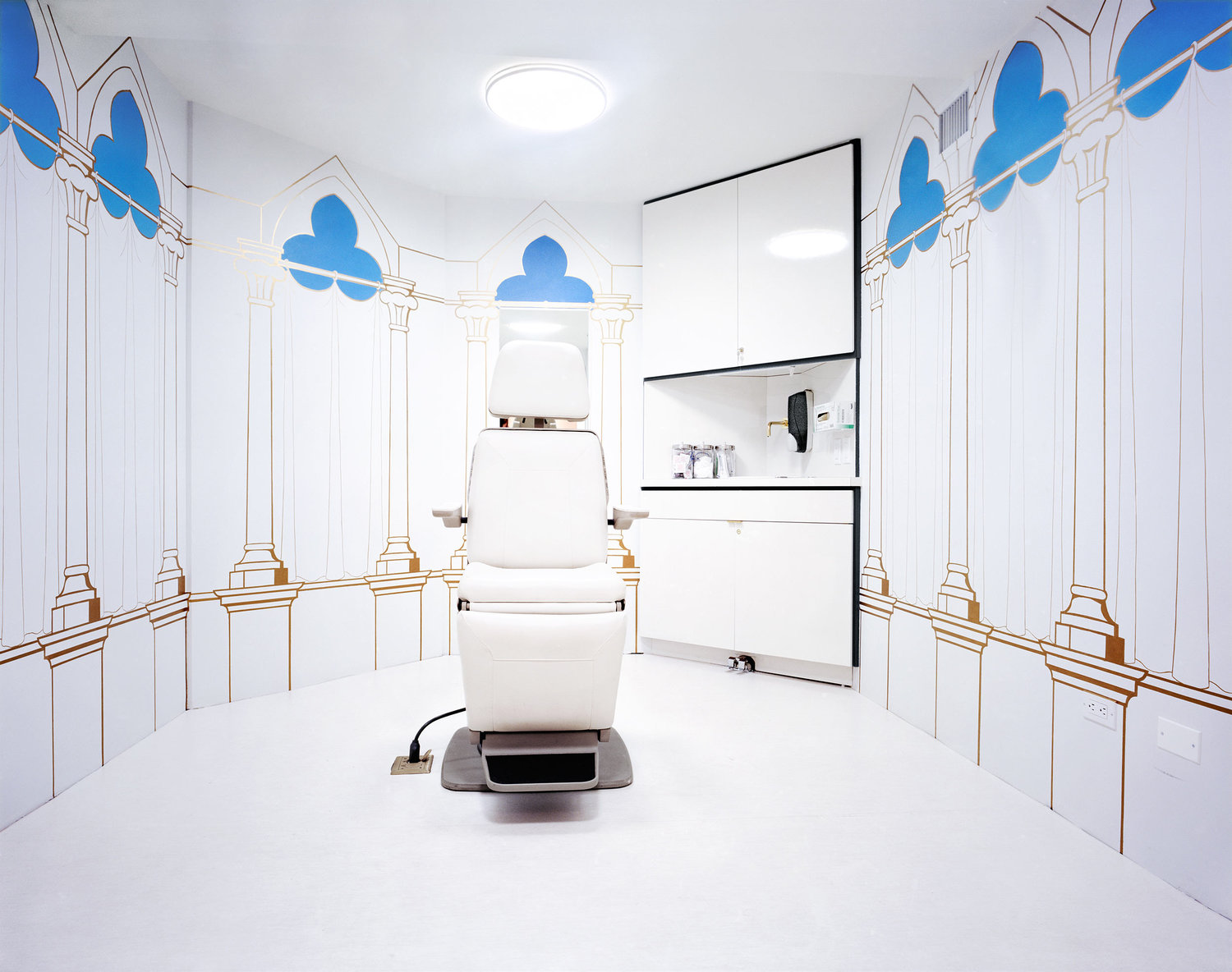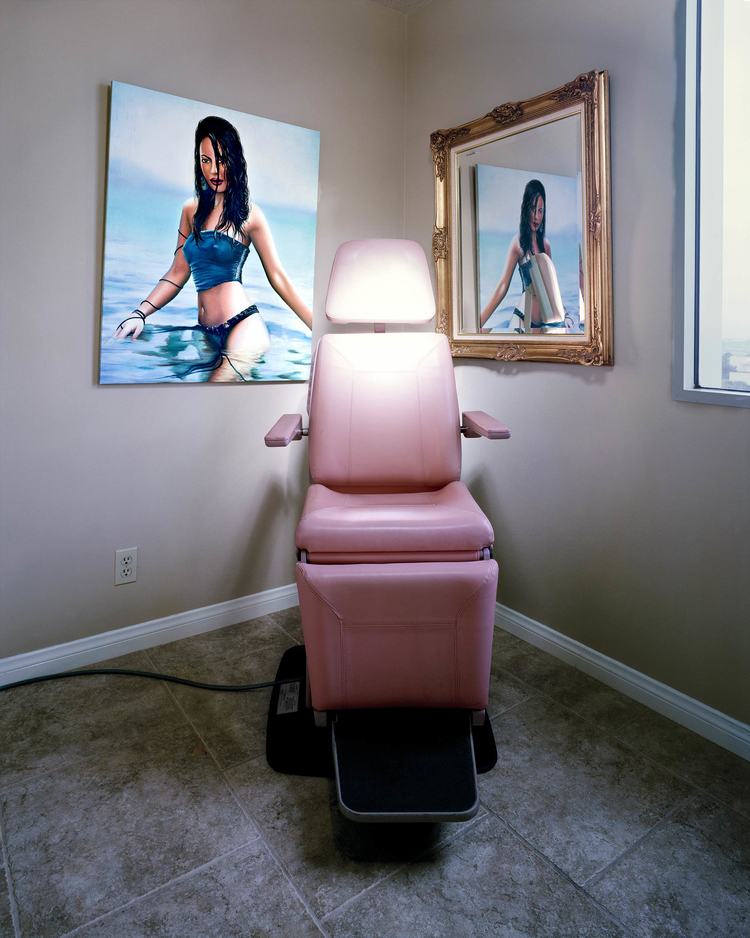
IN THE HISTORY OF Western dress, fashion has long been the predominant tool for creating ‘ideal’ bodily shapes by covering up, transcending and reshaping our ‘actual’ bodies.1 In 2015, this practice is still very much alive – just think of the use of shapewear and push-up bras. Over the last century however, shape-shifting has moved from the cloth that covers the flesh to the flesh itself; we live in a ‘makeover culture’ where cosmetic surgery has become commonplace.2
Like fashion, the cosmetic surgery industry is fuelled by continuous change. What started out as mostly scalpel surgery has transformed into a wider practice that also includes the use of fillers to make more temporary adjustments to lips, cheeks, hips and bottoms. As cultural studies scholar Meredith Jones puts it, ‘It is the new affordable and impermanent nature of much contemporary cosmetic surgery that brings it into alignment, symbolically and practically, with fashion.’3
While this might be considered a technological success, discourses of cosmetic surgery are also tightly interwoven with ideas of failure. Both those who justify and those who critique the practice describe it in terms of failure, though their interpretations are poles apart. What sort of failure does cosmetic surgery instantiate? Who fails, and who or what fails them?
Cosmetic surgery is founded on the twin supposition that bodies, especially female bodies, must be beautiful, and that they regularly fail to be so. The medicalised beauty industry represents the female body as both falling short and deteriorating. Although in its ageist logic, every body will fail eventually, the first cosmetic surgeons focused on the exceptionally failed body. To justify their interventions, they relied heavily on categories of disease and deformity. To have drooping eyelids, uneven breasts or a receding chin was, in other words, deemed literally pathological. Such pathologies, surgeons argued, had deep psychological effects that could be ameliorated with physical repair.
But deformed, diseased bodies are by definition exceptional bodies, and a body no longer needs to be exceptional to demand intervention. The reigning idea now is that all bodies can – and perhaps even should – be enhanced. Only a few decades ago, cosmetic surgery was a rare and exclusive practice; it is now widespread. In the U.S. alone, there were fifteen million procedures in 2014 (roughly double from 2007), if one includes non-surgical practices such as laser peels and injections.
In a recent cover story for Time magazine, medical journalist Joel Stein argues that cosmetic procedures will soon become both ubiquitous and obligatory.4 He describes South Korea as heavily populated with surgically modified citizens, and sees Western countries following suit. Medical cosmetic technologies, he argues, will become merely another activity of maintenance, upkeep and self-responsibility within the competitive markets of labour, consumption and lifestyle. Cosmetic surgery will not only be a mode of fashioning a normatively ideal body, but also a performance of neoliberal citizenship.
Undergoing a cosmetic procedure may, however, involve capitulation. Writing in the second person (and constructing his reader as middle-class, Western and female), Stein argues that ‘you’ will give in eventually: ‘You’re going to have to do it. And not all that long from now. Not because you hate yourself, fear aging or are vain. You’re going to get a cosmetic procedure for the same reason you wear makeup: because every other woman is.’5

Stein invokes a decades-long debate in feminism. While some feminists have argued that cosmetic surgery is a more or less pragmatic negotiation of gender norms, others insist that the ‘need’ for cosmetic surgery represents psychic failures. In this view, cosmetic surgery patients hate their bodies, or experience a form of ‘false consciousness.’
The stereotype of the self-loathing cosmetic surgery patient can also be found in the annals of psychiatry. Lacking much in the way of critique of gender norms, the mid-twentieth century psychiatric discourse addressed women who underwent cosmetic surgery as neurotics, disordered personalities or otherwise pathological subjects. Contemporary discussions of Body Dysmorphic Disorder similarly scrutinise the female psyche as vulnerable to self-hatred and, in addition, claim that they are susceptible to addiction. Such discussions feed into the belief that women – vulnerable, self-loathing and easily addicted – are responsible for the recent upsurge of cosmetic surgeries, instead of the other way around. There are good reasons to be wary of identifying the ‘surgery junkie’ as a culprit of the cosmetic surgery boom. After all, this logic lays the burden of cosmetic surgery’s problems on the shoulders of individual, mostly female patients, and ignores the institutional forces that account for its vast expansion.6
Whether cosmetic surgery corrects a failed body or suggests a failed psyche is an irrelevant question; in my view, these assumptions are both flawed. Instead, the explosion of cosmetic surgery is a symptom of catastrophic structural failures. In the U.S. and globally, its mass expansion is part of a broader turn toward enhancement medicine, where the ‘maximisation of lifestyle, potential, health, and quality of life has become almost obligatory,’ as sociologist Nick Rose puts it.7
This maximisation, however, takes place in a context of deepening social and economic inequality, one in which there is unequal access to health care, medical technologies and life-saving drugs, as well as food and environmental security. On a global scale, these disparities are extreme, but even within the U.S. context, according to the United States Centers for Disease Control and Prevention, life expectancy and other measures of health vary greatly by socioeconomic status, race and geographic location.8
Whether ‘you’ get cosmetic surgery in the future is not necessarily a measure of whether and how your body or psyche have failed you. It may depend more on your status in neoliberal capitalism. Cosmetic surgery and other forms of elective medicine are fostered by the profit-driven stratification of medicine. This system confers biomedical citizenship on those who can oblige demands for self-care, wellness and enhancement, while denying it to those who cannot. You are not failing, but our systems may be failing you.

This article was first published in Vestoj On Failure.
Victoria Pitts-Taylor is a professor of Feminist, Gender and Sexuality Studies at Wesleyan University.
Cara Phillips is a Brooklyn-based photographer, curator, writer and lecturer.
A Hollander, Seeing through Clothes, University of California Press, Berkeley and Los Angeles, 1993 [orig. 1975] ↩
M Jones, ‘New Clothes, New Faces, New Bodies: Cosmetic Surgery and Fashion,’ in S Bruzzi and P Church Gibson (eds), Fashion Cultures Revisited: Theories, Explorations and Analysis, Routledge, New York, 2013, p.294 ↩
Ibid., p.289 ↩
J Stein, ‘Nip. Tuck. Or Else,’ Time, June 18 2015 ↩
Ibid. ↩
D Sullivan, Cosmetic Surgery: The Cutting Edge of Commercial Medicine, Rutgers Univerity Press, New Brunswick, NJ, 2001 ↩
N Rose, The Politics of Life Itself, Princeton University Press, Princeton, NJ, 2006, p.25 ↩
Centers for Disease Control and Prevention (CDC), ‘CDC Health Disparities and Inequalities Report – United States, 2013,’ Morbidity and Mortality Weekly Report, Vol. 62, No. 3, 2013, pp.1-187 ↩